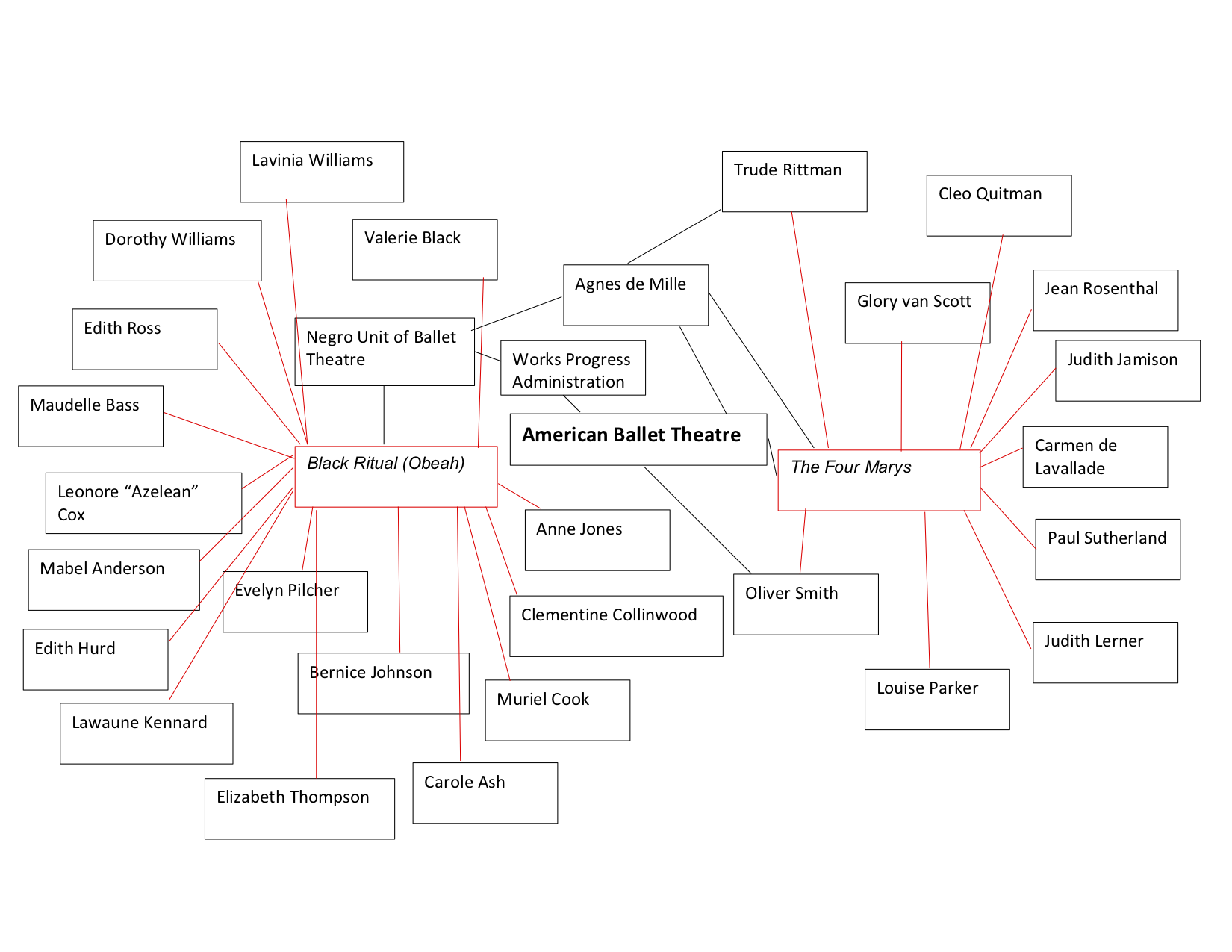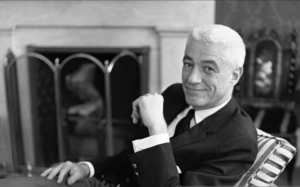About This Orbit: American Ballet Theatre
American Ballet Theatre, called the Ballet Theatre until 1957, was founded in 1939 by Lucia Chase and Richard Pleasant and presented its first performance on January 11, 1940. The company, now recognized as one of the world’s leading classical ballet companies, was intended to represent the budding American style of ballet while simultaneously nodding to the classical European form. New works by American choreographers and European choreographers filled the repertoire. Some notable choreographers who worked with the Ballet Theatre were Russians Michel Fokine and Bronislava Nijinska, Englishmen Andrée Howard and Antony Tudor via Ballet Rambert, and Americans Eugene Loring and Agnes de Mille.
The company was expansive from the outset, consisting of 20 principal dancers; 15 soloists; a company of 56; 11 composers; 11 designers; 11 choreographers; 18 composers; a Spanish unit of 19 dancers; and, finally, an all-Black unit of 16 dancers. This final unit, known as the Negro Unit of Ballet Theatre, emerged as a result of the Works Progress Administration Federal Theatre Project, which employed a large number of Black dancers and choreographers.
Source:
Works Progress Administration
The Works Progress Administration Federal Theatre Project sponsored the Negro Unit of Ballet Theatre, American Ballet Theatre’s only all-Black unit. This federal project employed a large number of Black dancers and choreographers across the country. Both American Ballet Theatre’s Negro Unit as well as the New York Negro Unit were founded in New York City.
Negro Unit of Ballet Theatre
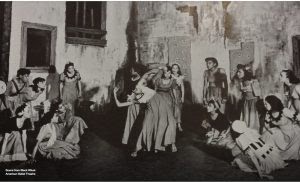
The Negro Unit of Ballet Theatre, set up by the aforementioned Federal Theatre Project, was made up of 16 Black dancers, including Lawaune Kennard, Lavinia Williams, Anne Jones, Dorothy Williams, Elizabeth Thompson, Evelyn Pilcher, Edith Ross, Valerie Black, Leonore “Azelean” Cox, Edith Hurd, Mabel Hart, Maudelle Bass, Clementine Collinwood, Carole Ash, Bernice Willis, and Muriel Cook.
The Negro Unit only performed one ballet during its existence, entitled Black Ritual or Obeah, which was choreographed by Agnes de Mille and set to a score by Darius Milhaud. Black Ritual was performed only three times over the course of the Ballet Theatre’s inaugural season in 1940, and upon the conclusion of the company’s three-week run at Radio City Music Hall, the Negro Unit was disbanded.
Sources:
Paula Becker, Negro Repertory Company, History Link
Bethany Beacham, The Beginning: The Negro Unit of Ballet Theatre and Agnes de Mille’s Black Ritual, American Ballet Theatre
Agnes de Mille

Born in New York City to a family of theater professionals, American dancer and choreographer Agnes de Mille aspired to be an actress, not seriously considering dance until after her college graduation. One of de Mille’s first jobs as a choreographer, thanks to her father’s connections, was for Cecil B. DeMille’s film Cleopatra (1934). De Mille was eventually recruited by co-founder of the Ballet Theatre, Richard Pleasant, to choreograph for the company.
De Mille went on to create Black Ritual or Obeah, the only ballet that the Negro Unit of Ballet Theatre would perform. In 1964-1965, in honor of the American Ballet Theatre’s 25th anniversary, de Mille choreographed The Four Marys, which featured Carmen de Lavallade, Judith Jamison, Cleo Quitman, and Glory van Scott.
Sources:
Agnes de Mille, Wikipedia
Bethany Beacham, The Beginning: The Negro Unit of Ballet Theatre and Agnes de Mille’s Black Ritual, American Ballet Theatre
Black Ritual
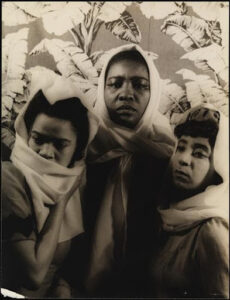
Black Ritual was created for the 16 Black female dancers in the Negro Unit by Agnes de Mille. The work told the story of a group of “primitive” women who agreed to kill one of their group members. First performed one week into Ballet Theatre’s inaugural season, on January 22, 1940, the work marked the first time Black dancers had appeared in a large-scale production from what was a typically all-white ballet company.
Sources:
Maher, Erin K. “Ballet, Race, and Agnes de Mille’s Black Ritual.” The Musical Quarterly, vol. 97, no. 3, Fall 2014, pp. 390-428.
Bethany Beacham, The Beginning: The Negro Unit of Ballet Theatre and Agnes de Mille’s Black Ritual, American Ballet Theatre
Lavinia Williams
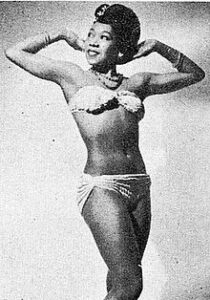 Lavinia Williams was born in Philadelphia, PA in 1916 and grew up in Brooklyn, New York. Williams joined the first American Negro Ballet in 1937 with Eugene Von Grona. When the American Negro Ballet disbanded in 1940, Williams went to dance with the Negro Unit of Ballet Theatre. After the performance of Black Ritual, she was invited to join Katherine Dunham’s company, where she stayed until 1945. Williams toured Europe and appeared in Broadway shows like Showboat, Finian’s Rainbow, and My Darling. In 1953 Williams moved to Haiti to continue teaching dance until 1980. She helped found the National School of Dance and the National Dance Troupe of Jamaica, along with the Haitian Institute of Folklore and Classical Dance.
Lavinia Williams was born in Philadelphia, PA in 1916 and grew up in Brooklyn, New York. Williams joined the first American Negro Ballet in 1937 with Eugene Von Grona. When the American Negro Ballet disbanded in 1940, Williams went to dance with the Negro Unit of Ballet Theatre. After the performance of Black Ritual, she was invited to join Katherine Dunham’s company, where she stayed until 1945. Williams toured Europe and appeared in Broadway shows like Showboat, Finian’s Rainbow, and My Darling. In 1953 Williams moved to Haiti to continue teaching dance until 1980. She helped found the National School of Dance and the National Dance Troupe of Jamaica, along with the Haitian Institute of Folklore and Classical Dance.
Sources:
Lavinia Williams Collection, New York Public Library Archive
Lavinia Williams, 73, a Dancer, The New York Times
Women’s History Month: Lavinia Williams, Dot Complicated
Elizabeth Thompson
 Elizabeth Ann (Betty Ann) Thompson was born in Harlem in 1936 and began dancing at 12 years old in her church musical theater group. Ms. Thompson attended the Juilliard School but would leave to pursue a professional career performing with Les Ballets Negres, the predecessor to the New York Negro Ballet. In 1966, the Radio City Ballet Company hired Thompson—a pioneer woman of color in a predominantly white corps; she performed with the company full-time until the company’s demise in 1975 and part-time until 1979. She also performed with Walter Nix. Thompson taught dance at Dance Theatre of Harlem and was the dance mistress at Ballet Hispanico for six years, as well as teaching in France.
Elizabeth Ann (Betty Ann) Thompson was born in Harlem in 1936 and began dancing at 12 years old in her church musical theater group. Ms. Thompson attended the Juilliard School but would leave to pursue a professional career performing with Les Ballets Negres, the predecessor to the New York Negro Ballet. In 1966, the Radio City Ballet Company hired Thompson—a pioneer woman of color in a predominantly white corps; she performed with the company full-time until the company’s demise in 1975 and part-time until 1979. She also performed with Walter Nix. Thompson taught dance at Dance Theatre of Harlem and was the dance mistress at Ballet Hispanico for six years, as well as teaching in France.
Sources:
Joselli Audain Deans: Elizabeth Thompson, telephone interview by author, December 15, 2000, Philadelphia, PA, tape recording.
Elizabeth Hubbard, 76, Dancer and Beloved Gardener, AMNY
Black Swans Shattering the Glass Ceiling, La’Toya Princess Jackson
Lawaune Kennard

Lawaune Kennard, born in 1919, studied with Martha Graham and Franziska Boas and was a member of the Negro Unit of Ballet Theatre and the Negro Dance Company. Kennard performed in Swingin’ the Dream (1939); with Katherine Dunham’s company in Cabin in the Sky, which was filmed in 1943 and starred Lena Horne; in Dunham’s 1943 (or 1944) Tropical Revue; in the 1945 Broadway musical Carib Song; as a lead dancer in the 1946 Bal Negre; and Show Boat in Chicago (1948). From 1949-1950, she toured with Talley Beatty’s revue throughout Europe and North American.
Sources:
Bernstein Meets Broadway: Collaborative Art in a Time of War by Carol J. Oja
Lawaune Ingram, Playbill
Maher, Erin K. “Ballet, Race, and Agnes de Mille’s Black Ritual.” The Musical Quarterly, vol. 97, no. 3, Fall 2014, pp. 390-428.
Anne Jones
Born in 1905, Anne Jones was a member of the Negro Unit of Ballet Theatre and was a part of the original cast of Agnes de Mille’s Black Ritual. Jones’ teachers included Alexandre Gavrilov (Ballets Russes), Ted Shawn, and Bill “Bojangles” Robinson. She taught at and ran a dance school in Harlem before and after performing in Black Ritual; Lena Horne was a student of this school.
Sources:
Black Ritual (Obeah), American Ballet Theatre
Maher, Erin K. “Ballet, Race, and Agnes de Mille’s Black Ritual.” The Musical Quarterly, vol. 97, no. 3, Fall 2014, pp. 390-428.
Dorothy Williams
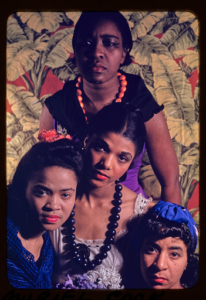
Dorothy Williams was born in 1916 and was a member of both the Negro Unit of Ballet Theatre and the American Negro Ballet. In 1936, Williams performed in the Federal Theatre Project’s production of Sweet Land. Williams also performed in the Broadway productions of Blackbirds of 1928; Shuffle Along (1932); Carmen Jones (1943); and Run, Little Chillun (1943).
Sources:
Black Ritual (Obeah), American Ballet Theatre
Bernstein Meets Broadway: Collaborative Art in a Time of War by Carol J. Oja
Dorothy Williams, Playbill
Maher, Erin K. “Ballet, Race, and Agnes de Mille’s Black Ritual.” The Musical Quarterly, vol. 97, no. 3, Fall 2014, pp. 390-428.
Evelyn Pilcher
Evelyn Pilcher, born in 1922, was a member of the Negro Unit of Ballet Theatre. She was a part of the original casts of Agnes de Mille’s Black Ritual and the Broadway shows Carmen Jones (1943) and Cabin in the Sky (1940), the latter of which was staged and choreographed by George Balanchine. In the 1950s, Pilcher also performed with La Verne French as “Velyn and La Verne.”
Sources:
Black Ritual (Obeah), American Ballet Theatre
Bernstein Meets Broadway: Collaborative Art in a Time of War by Carol J. Oja
Evelyn Pilcher, Playbill
Maher, Erin K. “Ballet, Race, and Agnes de Mille’s Black Ritual.” The Musical Quarterly, vol. 97, no. 3, Fall 2014, pp. 390-428.
Edith Ross
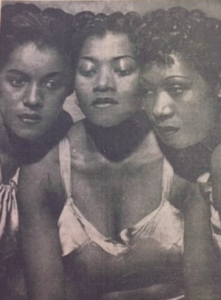 Edith Ross was a member of Eugene Von Grona’s American Negro Ballet, the Negro Unit of Ballet Theatre, and the Katherine Dunham Company from 1940 to 1943. She was a part of the original casts of Agnes de Mille’s Black Ritual and the Broadway shows Lew Leslie’s Blackbirds of 1939, Carmen Jones (1943-1945), and Cabin in the Sky (1940), which was staged and choreographed by George Balanchine.
Edith Ross was a member of Eugene Von Grona’s American Negro Ballet, the Negro Unit of Ballet Theatre, and the Katherine Dunham Company from 1940 to 1943. She was a part of the original casts of Agnes de Mille’s Black Ritual and the Broadway shows Lew Leslie’s Blackbirds of 1939, Carmen Jones (1943-1945), and Cabin in the Sky (1940), which was staged and choreographed by George Balanchine.
Sources:
Black Ritual (Obeah), American Ballet Theatre
Bernstein Meets Broadway: Collaborative Art in a Time of War by Carol J. Oja
Edith Ross, Playbill
Maher, Erin K. “Ballet, Race, and Agnes de Mille’s Black Ritual.” The Musical Quarterly, vol. 97, no. 3, Fall 2014, pp. 390-428.
Valerie Black

Valerie Cavell Black, born in 1917 in Colon, Panama, attended Bryant High School and Hunter College in New York City. She performed with Eugene Von Grona’s American Negro Ballet at their 1937 premiere at Lafayette Theatre. Black was also a member of Negro Unit of Ballet Theatre, performing in the 1940 premiere of Agnes de Mille’s Black Ritual. Black was featured in several Broadway shows; she was in the original casts of The Hot Mikado (1939), Big White Fog (as Caroline, 1940), Carmen Jones (1943), Lysistrata (1946), and Our Lan’ (as Ellen, 1947). She appeared in the film Beware! in 1946 and Aida with the National Negro Opera Company in 1941 as well as work on radio and in clubs.
Sources:
Pioneers in Negro Concert Dance: 1931 to 1937, Free to Dance
Valerie Black, Playbill
Maher, Erin K. “Ballet, Race, and Agnes de Mille’s Black Ritual.” The Musical Quarterly, vol. 97, no. 3, Fall 2014, pp. 390-428.
Inside the Playbill: Our Lan’, Playbill
Valerie Black, Native of Panama, Scores in “Anna Lucasta” Show, The New York Age, Dec 1, 1945
The Daily News, Oct 28, 1945
Night’s Dancer: The Life of Janet Collins
Leonore “Azelean” Cox
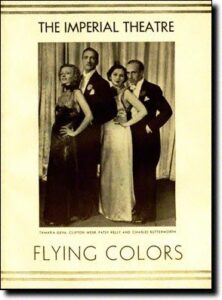
Leonore Cox was born in 1905 and grew up in Richmond, Virginia. Cox trained at the School of Modern Dancing and was a student at New York’s City College. As a member of the Negro Unit of Ballet Theatre, Cox was in the original 1940 cast of Agnes de Mille’s Black Ritual. Cox was also a member of the original Broadway cast of Flying Colors. As a dance critic and writer, Cox gave a lecture at the First National Dance Congress and Festival in 1936 as well as at the second conference in 1939. Additionally, she wrote an article for The Proceedings of the First National Dance Congress and Festival called “On a Few Aspects of Negro Dancing.”
Sources:
Black Ritual (Obeah), American Ballet Theatre
Leonore Cox, Playbill
Maher, Erin K. “Ballet, Race, and Agnes de Mille’s Black Ritual.” The Musical Quarterly, vol. 97, no. 3, Fall 2014, pp. 390-428.
Modern Dance, Negro Dance: Race in Motion, by Susan Manning
Opportunity: Journal of Negro Life
The Omaha Guide
Fighting for Hope, by Robert F. Jefferson
Edith Hurd
Edith Hurd was born in 1916 and was a member of the Negro Unit of Ballet Theatre. Hurd appeared in Agnes de Mille’s Black Ritual. She performed in the original Broadway casts of Lew Leslie’s Blackbirds of 1939, Swingin’ the Dream (1939), ‘Op-O’-Me Thumb (1924), and The Will O’ the Wisp (1923). Hurd was also featured in Carmen Jones on Broadway.
Sources:
Black Ritual (Obeah), American Ballet Theatre
Edith Hurd, Playbill
The Complete Books of 1930s Broadway Musicals by Dan Dietz
Mabel Anderson (née Hart)
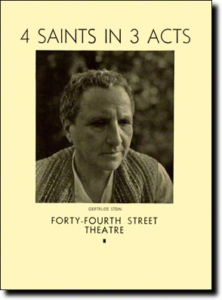
Playbill for Four Saints in Three Acts.
Born in 1916, Mabel Anderson (née Hart) was a member of the Negro Unit of Ballet Theatre. She was a part of the original cast of Agnes de Mille’s Black Ritual. Her Broadway credits include roles in Run, Little Chillun (1943); Carmen Jones (1943-1945); and Lost in the Stars (1949). In 1934, she was featured in Four Saints in Three Acts. With the Federal Theatre Project, Hart performed in Sweet Land (1936) and Pinocchio (1939). Her other theater credits include La Belle Helene (1941); Lysistrata (1946); and Show Boat (1948). In the 1930s, Hart taught dance at the Grace Giles Dancing School. She then founded the Mabel Hart Dance School in the 1950s.
Sources:
Black Ritual (Obeah), American Ballet Theatre
Bernstein Meets Broadway: Collaborative Art in a Time of War by Carol J. Oja
Mabel Hart, Playbill
Pioneers in Negro Concert Dance: 1931 to 1937, Free to Dance
Maher, Erin K. “Ballet, Race, and Agnes de Mille’s Black Ritual.” The Musical Quarterly, vol. 97, no. 3, Fall 2014, pp. 390-428.
Mable [sic] Hart Dance Studio, BAM Archives
Maudelle Bass
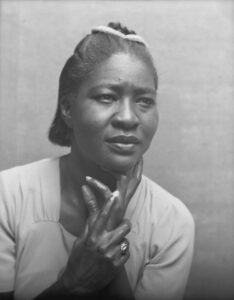
Maudelle Bass studied modern dance at the Gray Conservatory of Music of Art. She trained with Isobel Keith Morrison and Lester Horton. She also studied Nigerian Dance at the Fowler School of African Culture. In the 1930s, Bass danced and toured with the Arte Folklorico de Mexico.
Sources:
Black Ritual (Obeah), American Ballet Theatre
“Black Ritual” Ballet by Agnes de Mille for the Ballet Theatre, Museum of the City of New York
Maudelle Bass Is Dead; 1930’s Dancer Was 81, The New York Times
Photo by Johan Hagemeyer
Maudelle Bass Weston, Wikipedia
Maher, Erin K. “Ballet, Race, and Agnes de Mille’s Black Ritual.” The Musical Quarterly, vol. 97, no. 3, Fall 2014, pp. 390-428.
Maudelle Bass Weston, Oxford African American Studies Center
Clementine Collinwood
 Clementine Collinwood (also known as Clemie Collinwood) was a member of the Negro Unit of Ballet Theatre. She was a part of the original cast of Agnes de Mille’s Black Ritual (1940). Collinwood was also a part of the original Broadway cast of Swingin’ the Dream, which premiered November 29, 1939.
Clementine Collinwood (also known as Clemie Collinwood) was a member of the Negro Unit of Ballet Theatre. She was a part of the original cast of Agnes de Mille’s Black Ritual (1940). Collinwood was also a part of the original Broadway cast of Swingin’ the Dream, which premiered November 29, 1939.
Sources:
Black Ritual (Obeah), American Ballet Theatre
Clemie Collinwood, Playbill
Maher, Erin K. “Ballet, Race, and Agnes de Mille’s Black Ritual.” The Musical Quarterly, vol. 97, no. 3, Fall 2014, pp. 390-428.
Carole Ash
Carole Ash was a member of the Negro Unit of Ballet Theatre. She was a part of the original cast of Agnes de Mille’s Black Ritual (1940). It is not known where Ash was raised, trained, or performed other than with ABT’s Negro Unit.
Sources:
Black Ritual (Obeah), American Ballet Theatre
Maher, Erin K. “Ballet, Race, and Agnes de Mille’s Black Ritual.” The Musical Quarterly, vol. 97, no. 3, Fall 2014, pp. 390-428.
Bernice Johnson (née Willis)

Bernice Willis, born 1911, attended the Grace Giles Dancing School. Willis was in the original 1940 cast of Agnes de Mille’s Black Ritual as a member of the ABT Negro Unit. For almost 50 years of her career, Willis founded and ran the Bernice Johnson Cultural Arts Center in Queens, New York. The school’s alumni include Camille A. Brown, Roger C. Jeffrey, and Michael Peters.
Sources:
Black Ritual (Obeah), American Ballet Theatre
Bernice Willis, Playbill
Roger C. Jeffrey, Interview En L’Air
Illuminating the Invisible: An Interview with Dancer/Choreographer Camille A. Brown, Stage Directors and Choreographers Society
Michael Peters, Wikipedia
Muriel Cook
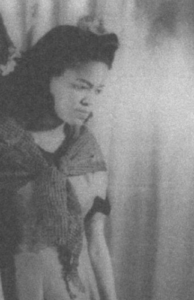 Born in 1915, Muriel Cook was a member of the Negro Unit of Ballet Theatre. She was a part of the original cast of Agnes de Mille’s Black Ritual (1940). Cook performed in the original Broadway casts of Flying Colors (1932), Lew Leslie’s Blackbirds of 1939, Swingin’ the Dream (1939), and Big White Fog (1940). Cook worked as a singer, performing in Harlem clubs, at Broadway revues, and on tour in South America and Europe.
Born in 1915, Muriel Cook was a member of the Negro Unit of Ballet Theatre. She was a part of the original cast of Agnes de Mille’s Black Ritual (1940). Cook performed in the original Broadway casts of Flying Colors (1932), Lew Leslie’s Blackbirds of 1939, Swingin’ the Dream (1939), and Big White Fog (1940). Cook worked as a singer, performing in Harlem clubs, at Broadway revues, and on tour in South America and Europe.
Sources:
“Black Ritual” Ballet by Agnes de Mille for the Ballet Theatre, Museum of the City of New York
Muriel Cook, Playbill
Bass, Maudelle, with Muriel Cook, Lawaune Kennard, and Dorothy Williams in Black Ritual (Obeah), Beinecke Rare Book & Manuscript Library
Maher, Erin K. “Ballet, Race, and Agnes de Mille’s Black Ritual.” The Musical Quarterly, vol. 97, no. 3, Fall 2014, pp. 390-428.
The Four Marys
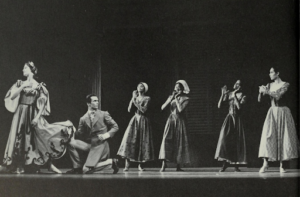 For the 25th anniversary of American Ballet Theatre in 1964-1965, Agnes de Mille choreographed The Four Marys, based loosely on The Ballad of Mary Hamilton, a 16th century Scottish song about an attendant to Mary Stuart, Queen of Scots. De Mille transports the story to the ante-bellum South, placing emphasis on a relationship between a white suitor and a Black maid rather than a king and a lady-in-waiting.
For the 25th anniversary of American Ballet Theatre in 1964-1965, Agnes de Mille choreographed The Four Marys, based loosely on The Ballad of Mary Hamilton, a 16th century Scottish song about an attendant to Mary Stuart, Queen of Scots. De Mille transports the story to the ante-bellum South, placing emphasis on a relationship between a white suitor and a Black maid rather than a king and a lady-in-waiting.
Sources:
Ballet: ‘The Four Marys’, The New York Times
Dancing Spirit: An Autobiography, Judith Jamison
Judith Jamison
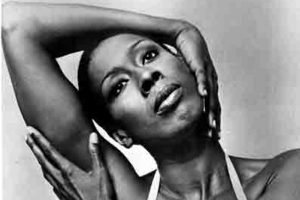 Born in 1943 in Philadelphia, Judith Jamison ascended the ranks of stardom in the ballet world. After seeing Jamison in a masterclass, Agnes de Mille invited her to perform in her new work, The Four Marys for American Ballet Theatre, playing Mary Seaton.
Born in 1943 in Philadelphia, Judith Jamison ascended the ranks of stardom in the ballet world. After seeing Jamison in a masterclass, Agnes de Mille invited her to perform in her new work, The Four Marys for American Ballet Theatre, playing Mary Seaton.
Jamison would go on to serve as a dancer, muse, friend, and successor to Mr. Alvin Ailey. She would carry his spirit and legacy on in her body, while building her own as Artistic Director of the Alvin Ailey American Dance Theater for 21 years. With Ailey, Jamison saw the way inclusivity could exist onstage, in the studios, and in the world. While there is an overwhelming lack of diversity in the world of ballet still today, Ailey ensured that it did not exist in his company and Jamison relished in that.
Source:
And Still They Rose: Judith Jamison
Carmen de Lavallade
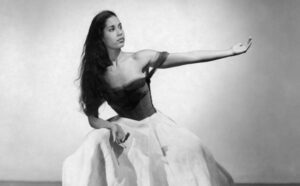 Carmen de Lavallade, born in New Orleans in 1931 and raised in Los Angeles, was inspired by her cousin Janet Collins to take up dancing. She studied under Melissa Blake and Carmelita Maracci, and her performance career began at age 17 with Lester Horton Dance Theater, where she danced with her high school friend Alvin Ailey.
Carmen de Lavallade, born in New Orleans in 1931 and raised in Los Angeles, was inspired by her cousin Janet Collins to take up dancing. She studied under Melissa Blake and Carmelita Maracci, and her performance career began at age 17 with Lester Horton Dance Theater, where she danced with her high school friend Alvin Ailey.
She toured with Ailey’s company in Europe and Asia, a tour which was sometimes billed as “de Lavallade-Ailey American Dance Company,” and performed in Agnes de Mille’s The Four Marys, playing the role of Mary Hamilton and The Frail Quarry with Ballet Theatre (now known as American Ballet Theatre). She was a principal dancer with both John Butler’s company and with the Metropolitan Opera Ballet, following in the footsteps of cousin Janet Collins.
Sources:
Women in Dance: Carmen de Lavallade, Jacob’s Pillow
Carmen de Lavallade, Wikipedia
Carmen de Lavallade, The Kennedy Center
Biography: Carmen de Lavallade, Thirteen
Cleo Quitman
In 1954, Quitman came to New York when she was 17 with intentions to enroll at the School of American Ballet. However, her entry was declined because it was mid-year/mid-season. Thus, she found herself training under the instruction of Mattie Gabor and Alfredo Corvino at the Metropolitan Opera School. Later Charles Neal would recommend her to Maria Nevelska, former member of the Bolshoi Ballet. Under Mme. Nevelska’s instruction, Quitman would later become one of the original six members of the New York Negro Ballet. Quitman later appeared as a guest artist with the American Ballet Theatre in Agnes De Mille’s The Four Marys (1961) in the role of Mary Beaton and with the Joffrey Ballet in Eugene Loring’s These Three (1966). Quitman and Bernard Johnson put together a blues African act and toured the continent with it for two years.
Sources:
Cleo Quitman: Girl On Her Toes (article)
Glory van Scott
Sources:
Glory Van Scott, Wikipedia
Glory Van Scott: Biography, The History Makers
Glory Van Scott: Her Life Among Legends, New York Trend NYC
Glory: A Life Among Legends, Water Street Press
Judith Taylor

Judith Taylor danced with American Ballet Theatre for five years, during which she danced under her maiden name of Judith Lerner. In The Four Marys, Taylor played the young woman whose suitor falls in love with one of her maids. After her time at ABT, Taylor ended her career as a dancer, citing a desire to go to college and get married.
Sources:
Roxbury’s Judith Taylor Career Path, The Litchfield County Times
Paul Sutherland
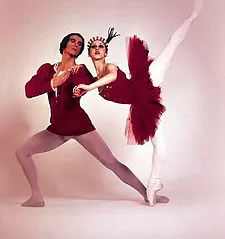
Paul Sutherland danced the role of the young woman’s suitor in American Ballet Theatre’s The Four Marys, the character who falls in love with Mary Hamilton, the young woman’s maid, and ultimately has a child with her.
Source:
Stager Paul Sutherland is still in the saddle, Ticket Sarasota
Louise Parker
 Louise Parker, an operatic contralto by trade, was selected to sing the part of the Narrator in American Ballet Theatre’s production of The Four Marys, singing stanzas crafted by Trude Rittman throughout the performance, usually to advance the plot of the show. Parker’s performance, heavily inspired by the Scottish source material, was given particular praise by the New York Times.
Louise Parker, an operatic contralto by trade, was selected to sing the part of the Narrator in American Ballet Theatre’s production of The Four Marys, singing stanzas crafted by Trude Rittman throughout the performance, usually to advance the plot of the show. Parker’s performance, heavily inspired by the Scottish source material, was given particular praise by the New York Times.
Sources:
Ballet: ‘The Four Marys’, The New York Times
Louise Parker Obituary, The New York Times
Louise Parker, Wikidata
Trude Rittman
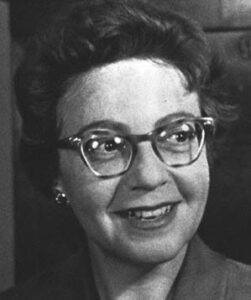 Trude Rittman, in collaboration with her longtime friend and artistic partner Agnes de Mille, composed the music for two pieces at American Ballet Theatre. The first was The Four Marys, based on “The Ballad of Mary Hamilton,” a sixteenth-century Scottish ballad, which premiered in 1965. The second was a collaboration with several other composers on The Informer, a piece rooted in Irish origins that premiered in 1988.
Trude Rittman, in collaboration with her longtime friend and artistic partner Agnes de Mille, composed the music for two pieces at American Ballet Theatre. The first was The Four Marys, based on “The Ballad of Mary Hamilton,” a sixteenth-century Scottish ballad, which premiered in 1965. The second was a collaboration with several other composers on The Informer, a piece rooted in Irish origins that premiered in 1988.
Sources:
The Four Marys, American Ballet Theatre
The Informer, American Ballet Theatre
Trude Rittman Obituary, The Independent
Trude Rittman scores, New York Public Library
Trude Rittman, American Ballet Theatre
Trude Rittman, Playbill
Oliver Smith
In 1944, Oliver Smith began his association with American Ballet Theatre (ABT), working on design for Jerome Robbins’ and Leonard Bernstein’s Fancy Free, a wildly successful ballet. In 1945, Smith took on the position of co-director of ABT with Lucia Chase, continuing in that position for the next 35 years, and contributing greatly to the growth and development of the Theatre as a whole.
In 1965, Smith served as the scenic designer for American Ballet Theatre’s The Four Marys, creating a set evocative of the antebellum setting of the show. The set was composed of five white columns, bringing images of Southern plantation architecture, some fragments of window shades, and a window frame, presumably used within the ballet.
Sources:
Ballet: ‘The Four Marys’, The New York Times
Oliver Smith Obituary, The New York Times
Oliver Smith, American Ballet Theatre
Set Designer, Oliver Smith, The WOW Report
Jean Rosenthal
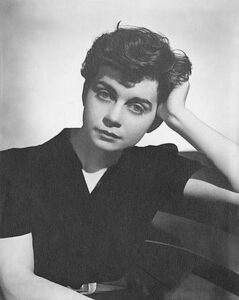 Jean Rosenthal served as lighting designer for The Four Marys, one of over thirty collaborations with American Ballet Theatre. Rosenthal designed the lighting color palette of the show using primarily blues and reds, matching the red of the “Four Marys’” costumes.
Jean Rosenthal served as lighting designer for The Four Marys, one of over thirty collaborations with American Ballet Theatre. Rosenthal designed the lighting color palette of the show using primarily blues and reds, matching the red of the “Four Marys’” costumes.



Sources:
Jean Rosenthal, American Ballet Theatre
Jean Rosenthal, Women in Lighting
Main Page Sources:
American Ballet Theatre, Britannica
Ballet, Race, and Agnes de Mille’s Black Ritual, The Musical Quarterly
Federal Theater Project (Negro Units) by Dr. Anthony D. Hill, Black Past
Agnes de Mille, Wikipedia
The Beginning: The Negro Unit of Ballet Theatre and Agnes de Mille’s Black Ritual, American Ballet Theatre
Documenting the Black Ballerina in A Ballerina’s Tale: The Limits of Celebration
Classic Dance and Race: A Story Still Unfolding, The New York Times
Dancing Spirit: An Autobiography – Judith Jamison, Howard Kaplan
Ballet: ‘The Four Marys’
Louise Parker Is Dead; An Operatic Contralto
American Ballet Theatre Records
Federal Theatre Project Negro Units
Paula Becker, Negro Repertory Company, History Link

Ryan Crants, McClain Groff, and Caprice Turchiano
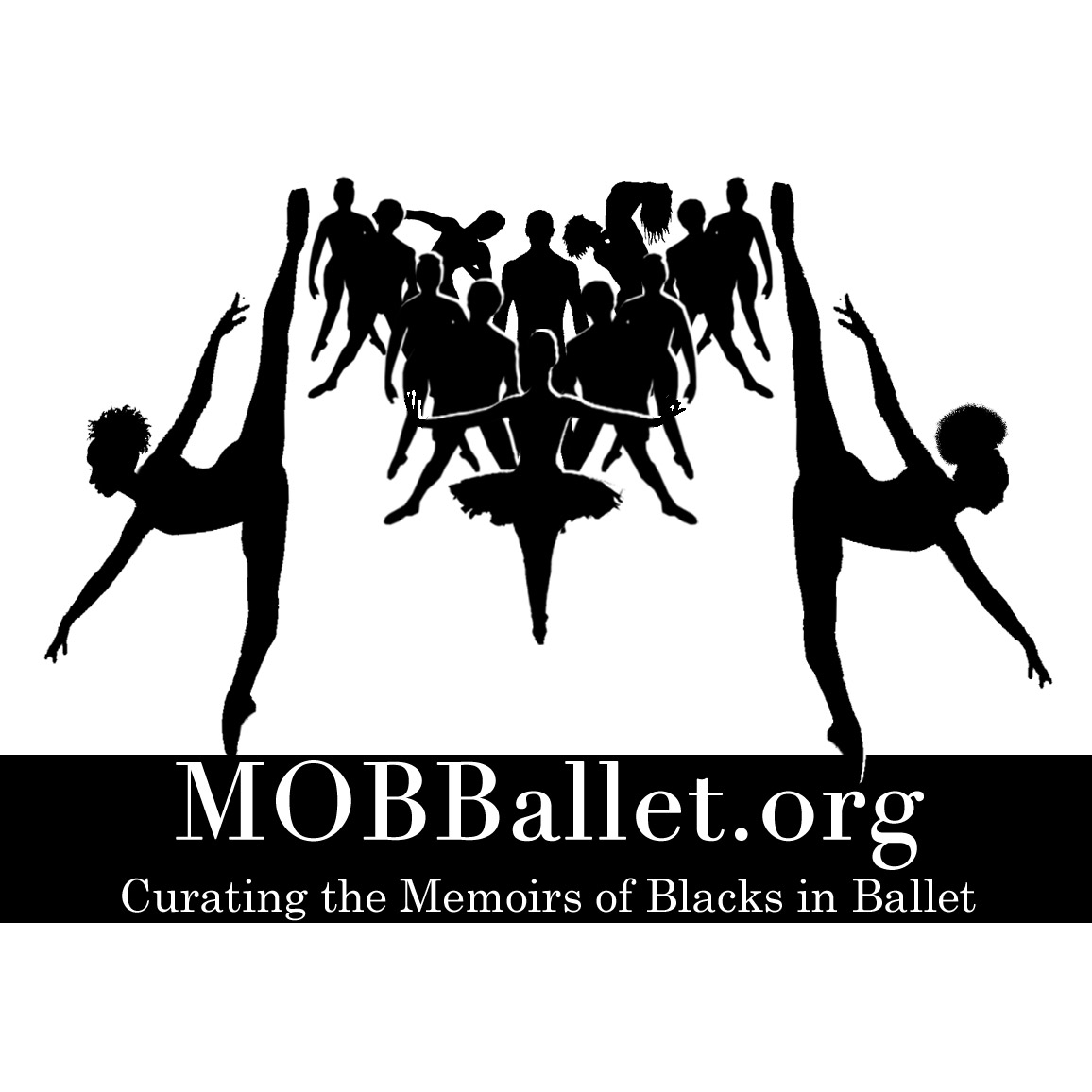
Madeline Crawford

